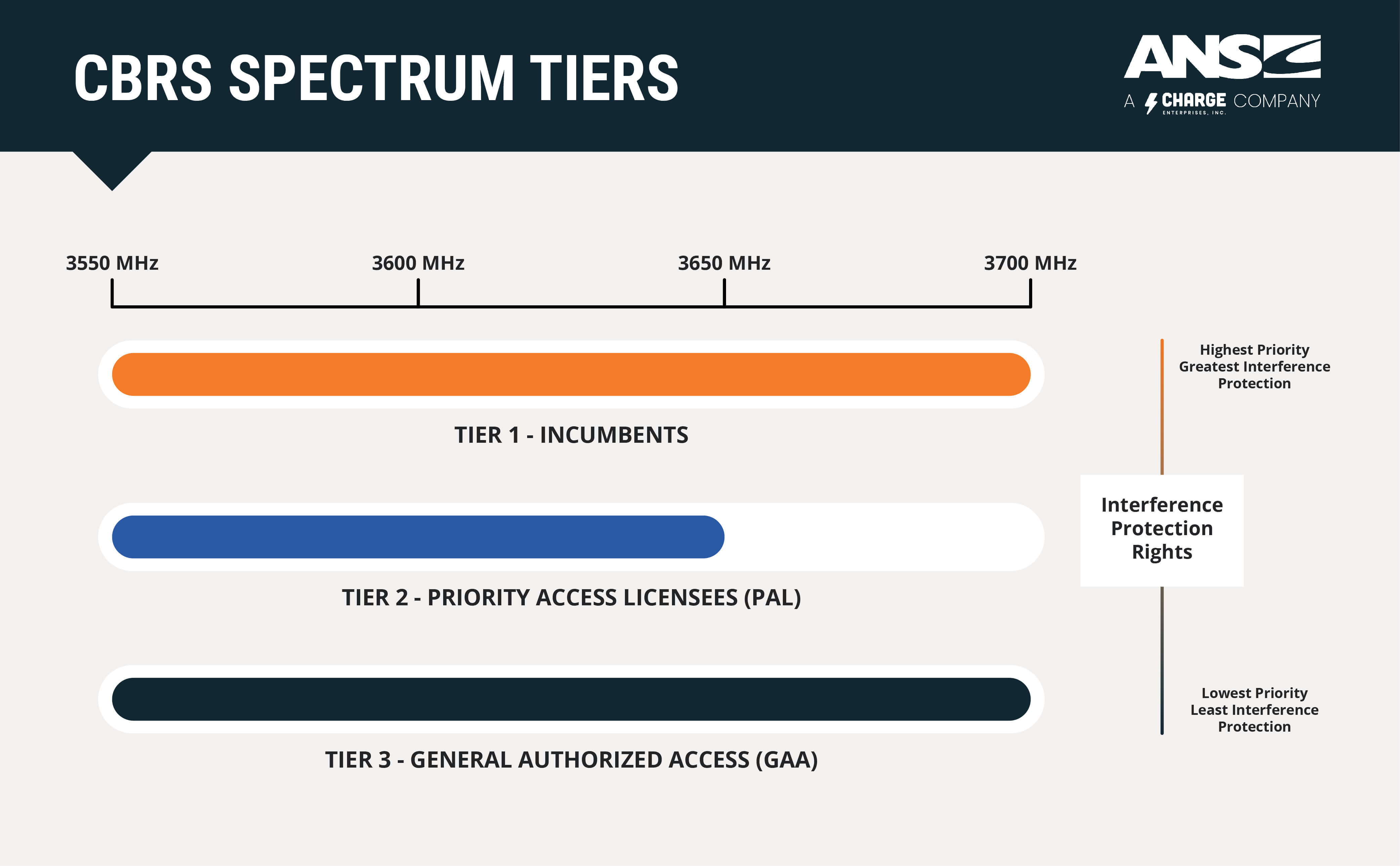Welcome to the world of wireless innovation, where the Citizen Broadband Radio Service (CBRS) is making waves by redefining how organizations access and utilize spectrum resources.
CBRS provides an efficient way for businesses to leverage wireless connectivity without breaking the bank thanks to its shared spectrum model combined with low cost of entry and high-performance capabilities.
Let’s demystify CBRS, shed light on its remarkable benefits, and highlight some groundbreaking use cases that are transforming industries.
What is CBRS and How Does it Work?
Citizen Broadband Radio Service (CBRS) is a wireless communication framework in the United States that allows shared access to the 3.5 GHz frequency band (3550 MHz to 3700 MHz) for commercial deployment of private cellular 4G and 5G networks. CBRS aims to optimize the use of the spectrum by enabling multiple users to share the available frequency resources without causing interference or compromising performance.
Let’s take a closer look at the CBRS architecture and the key components that bring it all together.
Regulatory Components
The Federal Communications Commission (FCC) has established a spectrum-sharing framework for CBRS. Here’s a breakdown of the three tiers.
- Incumbent Access - This tier includes federal users (e.g., military radar systems) and Fixed Satellite Service (FSS) earth stations, which have the highest priority and are protected from interference by other CBRS users.
- Priority Access License (PAL) - PAL holders are granted exclusive access to a portion of the 3.5 GHz band for a specific geographic area. PALs are allocated through an auction process and provide licensees with interference protection from General Authorized Access (GAA) users.
- General Authorized Access (GAA) - The GAA category allows any user with an FCC-certified device to access the remaining unlicensed portions of the 3.5 GHz band, provided they do not cause interference with higher-tier users.

Technical Components
To manage the shared use of the 3.5 GHz band, the CBRS framework employs a dynamic frequency sharing Spectrum Access Systems (SASs). SASs are cloud-based services that dynamically assigns and manages the available spectrum among all CBRS users, ensuring efficient use of as much of the CBRS band as possible, while preventing interference between different tiers.
CBRS devices, known as Citizens Broadband Radio Service Devices (CBSDs), that are the devices broadcasting in the CBRS spectrum, are required to communicate with the network core and a SAS to obtain and maintain spectrum access. The SAS considers factors such as the device's location, operational parameters, and priority tier to assign appropriate frequency channels.
What is the Role of the OnGo Alliance in the CBRS Ecosystem?
The OnGo Alliance, formerly known as the CBRS Alliance, is an industry organization that promotes the development, commercialization, and adoption of spectrum sharing frameworks and has taken the lead on the Citizen Broadband Radio Service (CBRS) in the United States. Its primary responsibilities include:
- Establishing Industry Standards - The OnGo Alliance works to develop and promote common technical specifications and standards for CBRS devices, ensuring interoperability and seamless integration within the ecosystem.
- Certification Programs - The alliance manages the OnGo Certification Program, which validates that devices and infrastructure components meet the necessary requirements for operating in the CBRS spectrum. This certification helps maintain a high level of quality and reliability across the ecosystem.
- Advocacy and Education - The alliance actively engages with regulators, policymakers, and industry leaders to advocate for the benefits of CBRS and educate them on the potential use cases and applications. This helps create a supportive regulatory environment for the growth of the CBRS ecosystem.
- Promoting Adoption - By showcasing the success stories of CBRS-based solutions, the OnGo Alliance drives awareness and encourages the adoption of CBRS technologies across industries.
The alliance consists of a diverse group of stakeholders, including mobile network operators, equipment manufacturers, system integrators, and other technology companies. ANS is a proud member of the OnGo Alliance.
How Can CBRS Benefit Your Organization?
Leveraging the CBRS spectrum provides organizations with access to reliable, secure, and cost-effective carrier grade broadband networks that can be deployed faster than ever before. Here are a few key benefits that come with deploying a CBRS-based private 4G and 5G network.
- Spectrum Efficiency - By allowing shared access to the 3.5 GHz band, CBRS promotes efficient use of the limited spectrum resources and can help address the increasing demand for wireless connectivity.
- Cost-Effective Deployment - CBRS enables businesses to deploy private 4G LTE or 5G networks without having to invest in expensive licensed spectrum, making it a more affordable option for various industries.
- Improved Coverage and Capacity - CBRS can help enhance coverage and capacity in areas where traditional cellular networks may struggle, such as indoor environments or rural locations.
Notable CBRS Use Cases and Applications
The possibilities for CBRS are vast. Here are a few notable CBRS use cases to demonstrate its potential.
- Private Wireless Networks - Companies can deploy their own private LTE or 5G networks using CBRS spectrum to provide secure and reliable connectivity for their operations, such as in warehouses and manufacturing plants or on large campuses.
- Education and Healthcare - Schools, universities, and healthcare institutions can leverage the CBRS band to enhance their connectivity infrastructure, supporting e-learning, telemedicine, secure data transfer, and other critical applications.
- Venue Connectivity - Stadiums, arenas, and other large entertainment centers can use the CBRS spectrum to deploy dedicated networks for improved wireless connectivity, improved point of sale speed and experience, enhancing the user experience for attendees, as well as supporting mission critical voice and video applications via better coverage and capacity.
- Industrial IoT - CBRS spectrum can be used to support Industrial IoT applications that require low-latency and high-reliability connectivity, such as robotics, automation, and real-time monitoring in industries like oil and gas, mining, and agriculture.
- Smart Cities - CBRS spectrum can help enable smart city applications like traffic management, public safety, and environmental monitoring by providing wireless connectivity for sensors, cameras, and other connected devices.
Expand Your Wireless Capabilities With a CBRS-Based Private Network
The spectrum sharing approach deployed in the CBRS band is a promising framework for shared spectrum access that offers maximum spectrum use as well as numerous benefits for businesses and industries seeking cost-effective, reliable, and scalable wireless connectivity solutions.
Organizations interested in deploying a CBRS-based private network should partner with experienced managed service providers. Premier system integrators will conduct comprehensive network assessments and develop a strategy for deployment and integration.





